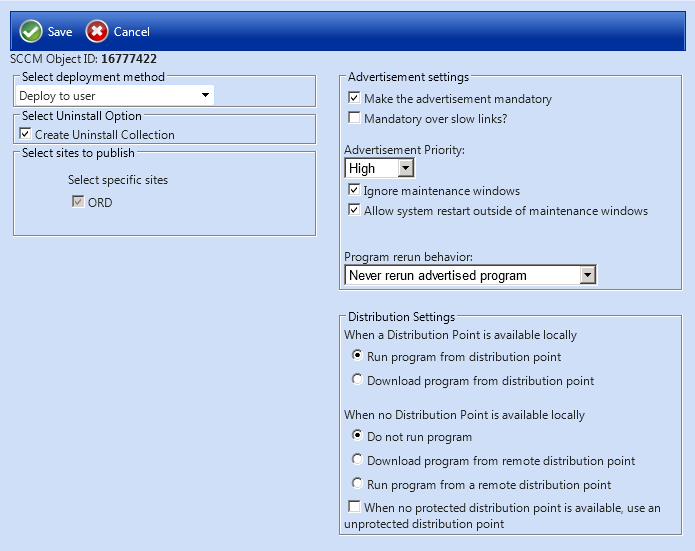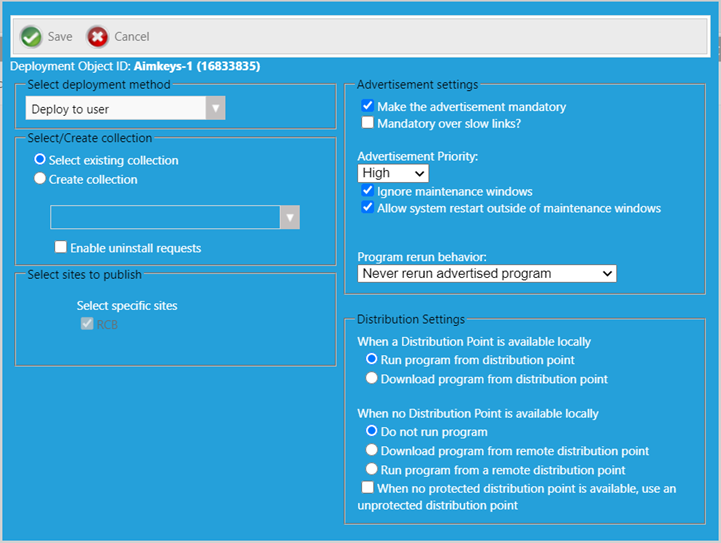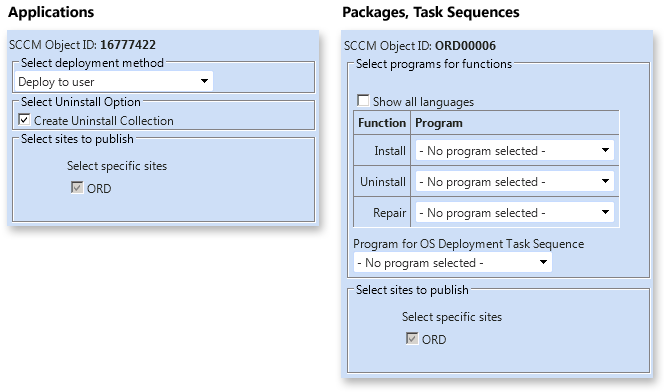SCCM Deployment Dialog Box
Note:Displayed for System Center Configuration Manager deployment technology only.
You can add programs to deploy a catalog item to System Center Configuration Manager through App Portal. When you are creating a new task sequence catalog item using the Catalog Item Properties dialog box, you add programs on the SCCM Deployment dialog box.
Note:When creating a new catalog item using the New Software Catalog Item Wizard, you enter deployment settings on the ConfigMgr/SCCM 2012 Deployment Settings Panel or ConfigMgr/SCCM 2012 Package Deployment Settings Panel.
When using the Catalog Item Properties dialog box to create a new catalog item, you open the SCCM Deployment dialog box by performing the following steps:
| • | Step 1: Open the Deployment > SCCM 2012, or ConfigMgr subtab. |
| • | Step 2: Click Add Package to open the Add Package Dialog Box. |
| • | Step 3: Select an application, package, or task sequence, and then click Add Program. |

SCCM Deployment Dialog Box (Applications)

ConfigMgr Deployment Dialog Box (Applications when Enable select of existing collection when creating/editing a catalog is enabled)
To open the SCCM Deployment dialog box for an existing catalog item, open the Deployment > SCCM 2012 tab and click New Deployment (for applications) or Add Program (for packages).
The SCCM Deployment dialog box displays different options in the SCCM Object area, depending upon the type of Software catalog item you are creating:

SCCM Object ID Area
The SCCM Deployment dialog box includes the following properties:
|
Property |
Description |
||||||||||||
|
Select deployment method |
(Applications only) Select one of the following options:
|
||||||||||||
|
Select existing collection |
(ConfigMgr Applications only) When Select existing collection is selected, pick the collection from the list which in turn enables Approve application requests for user per device feature for that catalog. |
||||||||||||
|
Enable uninstall requests |
(ConfigMgr Applications only) Select this option to enable uninstall requests. |
||||||||||||
|
Create collection |
Select this option to enable the Create uninstall collection option. |
||||||||||||
|
Create Uninstall Collection |
(Applications only) Select this option to create an uninstall collection. |
||||||||||||
|
Show all languages |
(Packages only) Select this option if you have multiple installation programs for different languages within a single request. Note:If programs are specified for more than one language, the requester will select the language during the checkout process. |
||||||||||||
|
Select programs for functions |
(Packages only) Select matching program name for each program function: Install, Uninstall, and Repair.
|
||||||||||||
|
Program for OS Deployment Task Sequence |
(Packages only) Select matching program name for the program function. |
||||||||||||
|
Select specific sites |
Select the sites where this request will be available, the locations you wish to publish the catalog item to. An advertisement and collection will be created at the site(s) selected. |
||||||||||||
|
Make the advertisement mandatory |
Determines whether the advertisement is created as a mandatory advertisement. |
||||||||||||
|
Mandatory over slow links? |
Select this option to require that the installation is run even when a client has a slow connection. If this option is not selected, the SCCM client agent will not perform the installation if the client has a slow connection, but will perform the installation if the client is connected over a regular LAN connection. |
||||||||||||
|
Advertisement Priority |
Specify the priority of the advertisement: High, Medium, or Low. |
||||||||||||
|
Ignore maintenance windows |
Determines if the advertisement should ignore maintenance windows. |
||||||||||||
|
Allow system restart outside of maintenance windows |
Select to allow the advertised program to restart the client even if the restart would occur outside a maintenance window. |
||||||||||||
|
Program rerun behavior |
Specifies whether the advertised program will be rerun on the client computer if it has previously been run before the scheduled mandatory time. Select one of the following options:
Important:This option is only enabled if Make the advertisement mandatory is also selected. |
||||||||||||
|
When a Distribution Point is available locally |
Select one of the following options to specify how content will be downloaded from the distribution points when a distribution point is available locally:
|
||||||||||||
|
When no Distribution Point is available locally |
Select one of the following options to specify how content will be downloaded from the distribution points when no distribution point is available locally:
|
||||||||||||
|
When no protected distribution point is available, use an unprotected distribution point |
Select this option to permit a client to use an unprotected distribution point if content is not immediately available on its protected distribution point. If this option is not selected, the client will not use unprotected distribution points. |
Note:For more information, see Attaching a Program to Deploy a Catalog Item to System Center Configuration Manager.
See Also
Attaching a Program to Deploy a Catalog Item to System Center Configuration Manager